Abstract
During perfusion of a plasma-like solution, colonic absorption rate of chloride was much higher than the secretion rate of bicarbonate (34 vs. 3.5 meq/h, respectively). This might suggest that anion exchange (Cl/HCO3) accounts for only a small fraction of total chloride absorption. However, if the colon absorbs as well as secretes bicarbonate, this reasoning would underestimate the magnitude of the anion exchange. To see if the colon absorbs bicarbonate, we perfused a chloride-free solution (which would eliminate bicarbonate secretion via (Cl/HCO3 exchange) and found that the colon absorbed bicarbonate at a rate of 5.1 meq/h. Calculation of electrochemical gradients and measurement of luminal fluid PCO2 indicated that this bicarbonate absorption was mediated passively in response to electrical gradients, rather than via reversed Cl/HCO3 exchange or acid secretion. The combined results of the plasma-like and chloride-free perfusion experiments suggest Cl/HCO3 exchange at a rate of 8.6 meq/h (the sum of bicarbonate movements, 3.5 and 5.1 meq/h, observed in the two experiments). To obtain a second estimate under different experimental conditions, a choline chloride-choline bicarbonate (sodium-free) solution was perfused; with this solution, chloride and bicarbonate absorption dependent on active sodium transport should be eliminated or markedly reduced, and the magnitude of Cl/HCO3 exchange should be revealed. This experiment suggested a Cl/HCO3 exchange rate of 9.3 meq/h, similar to the first estimate. As chloride was absorbed at a rate of 34 meq/h during perfusion of the plasma-like solution, the Cl/HCO3 exchange provides for approximately one-fourth of total chloride absorption.
Full text
PDF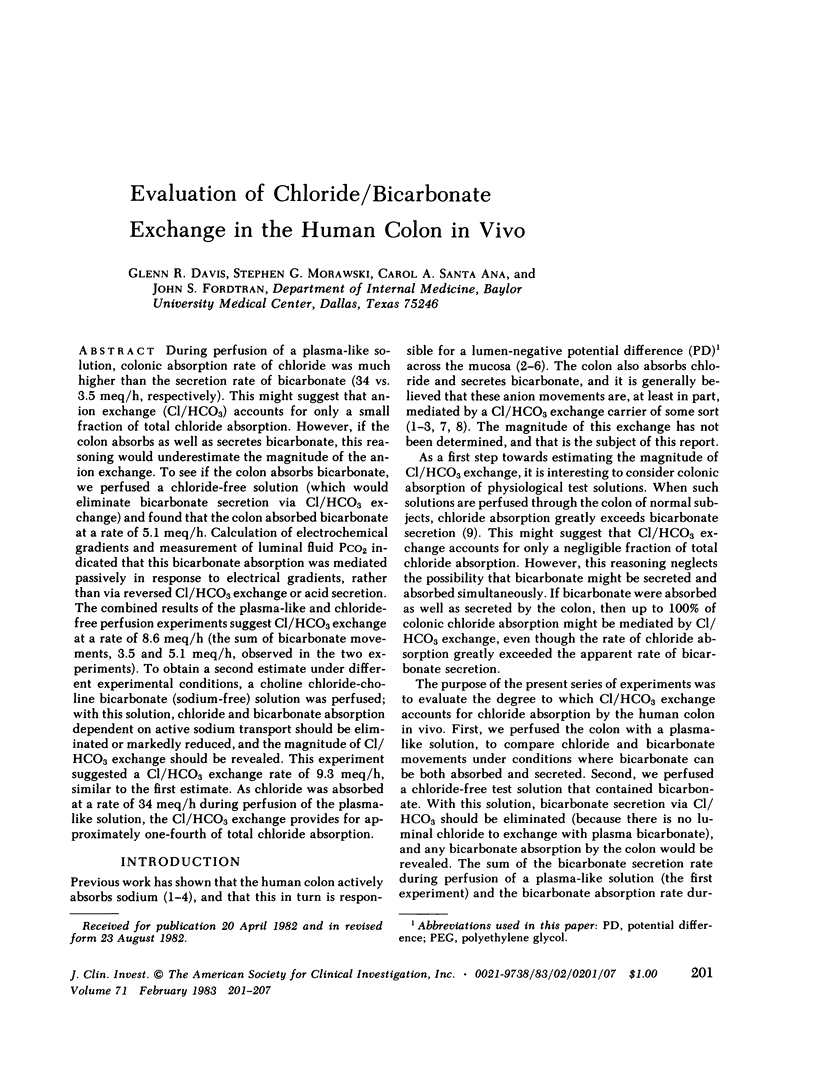
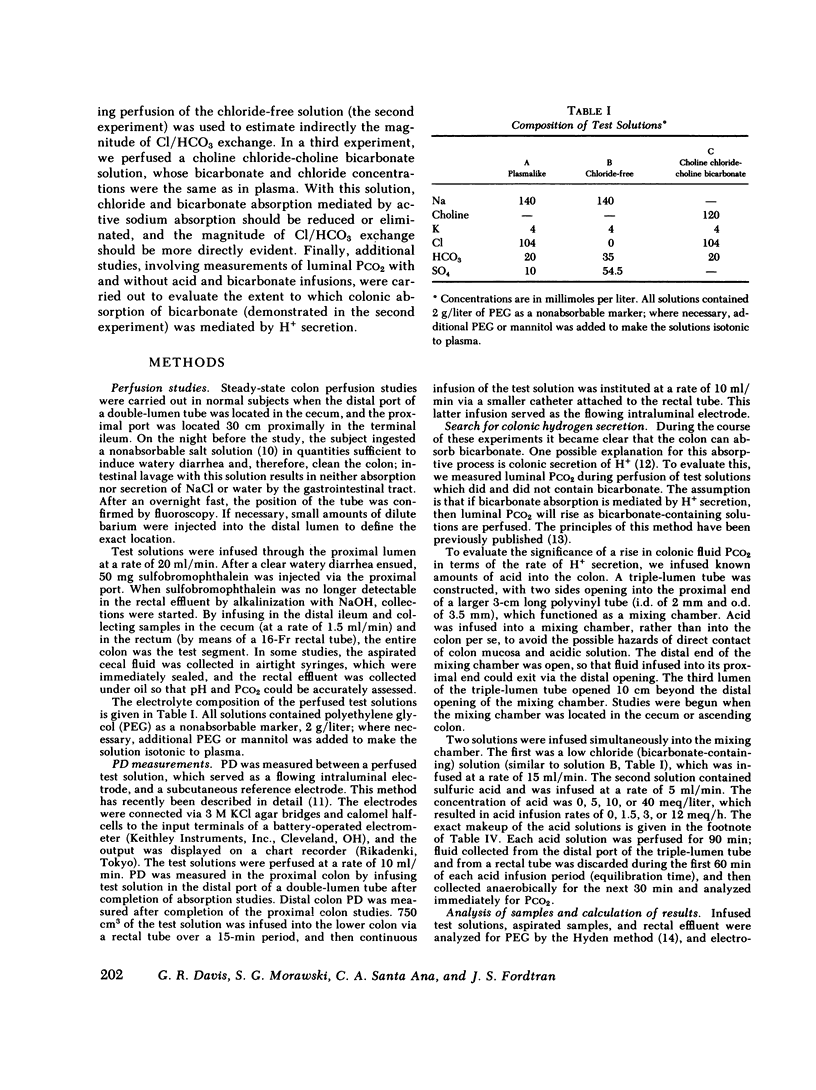
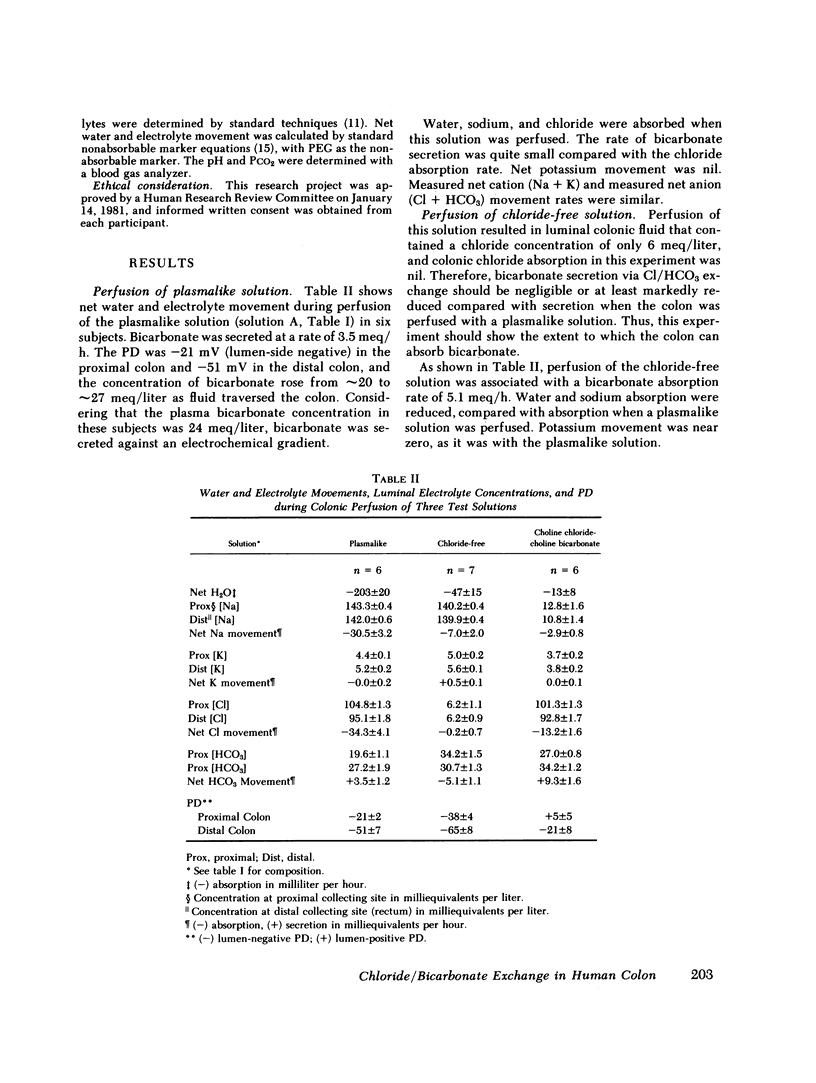
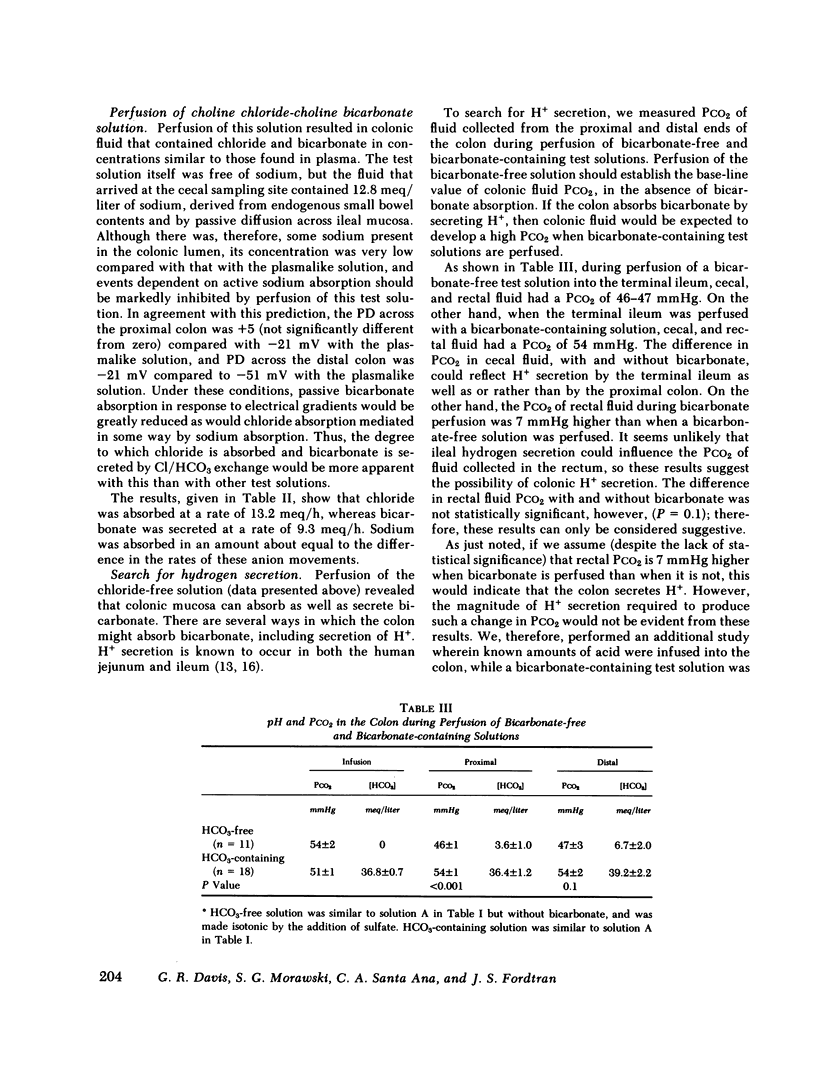

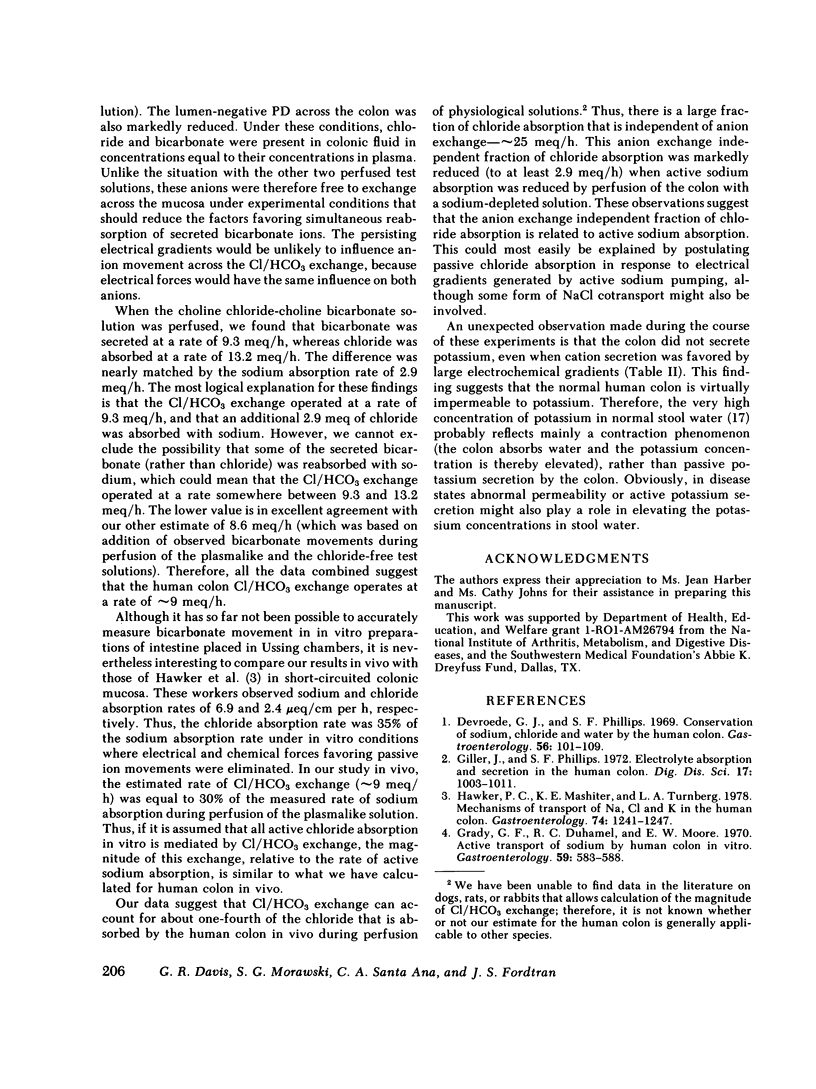
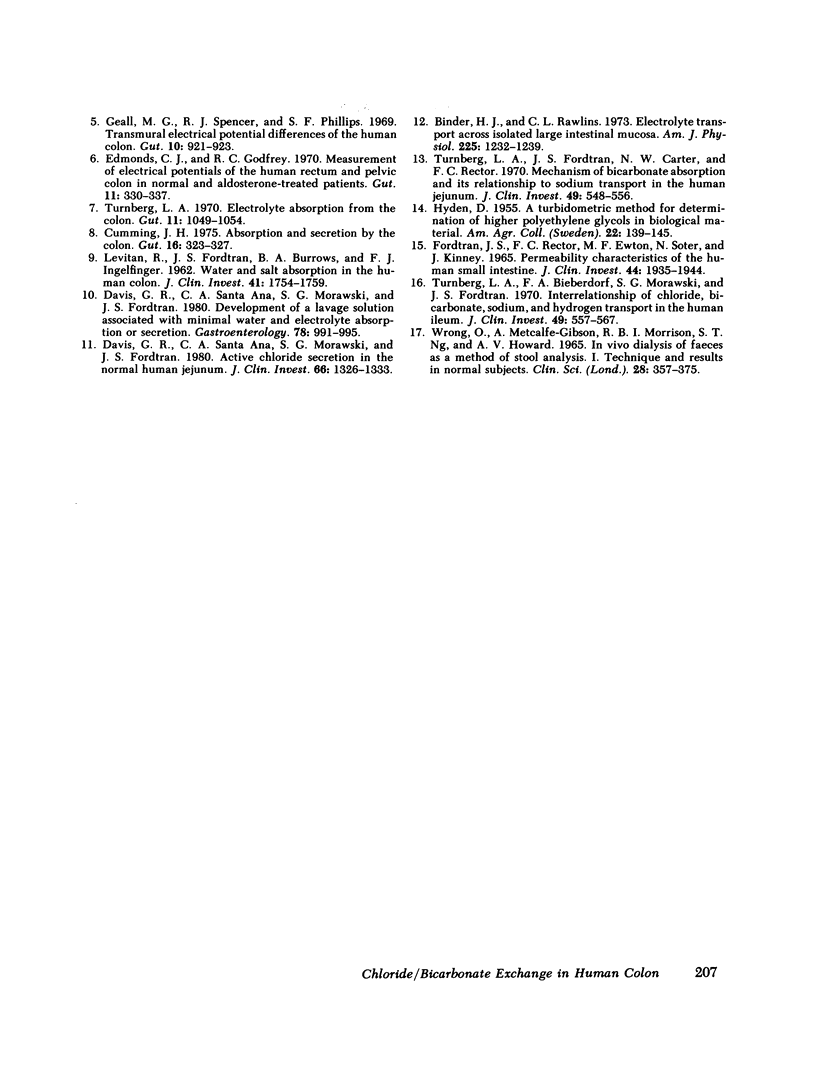
Selected References
These references are in PubMed. This may not be the complete list of references from this article.
- Binder H. J., Rawlins C. L. Electrolyte transport across isolated large intestinal mucosa. Am J Physiol. 1973 Nov;225(5):1232–1239. doi: 10.1152/ajplegacy.1973.225.5.1232. [DOI] [PubMed] [Google Scholar]
- Cummings J. H. Absorption and secretion by the colon. Gut. 1975 Apr;16(4):323–329. doi: 10.1136/gut.16.4.323. [DOI] [PMC free article] [PubMed] [Google Scholar]
- Davis G. R., Santa Ana C. A., Morawski S. G., Fordtran J. S. Development of a lavage solution associated with minimal water and electrolyte absorption or secretion. Gastroenterology. 1980 May;78(5 Pt 1):991–995. [PubMed] [Google Scholar]
- Davis G. R., Santa Ana C. A., Morawski S., Fordtran J. S. Active chloride secretion in the normal human jejunum. J Clin Invest. 1980 Dec;66(6):1326–1333. doi: 10.1172/JCI109985. [DOI] [PMC free article] [PubMed] [Google Scholar]
- Devroede G. J., Phillips S. F. Conservation of sodium, chloride, and water by the human colon. Gastroenterology. 1969 Jan;56(1):101–109. [PubMed] [Google Scholar]
- Edmonds C. J., Godfrey R. C. Measurement of electrical potentials of the human rectum and pelvic colon in normal and aldosterone-treated patients. Gut. 1970 Apr;11(4):330–337. doi: 10.1136/gut.11.4.330. [DOI] [PMC free article] [PubMed] [Google Scholar]
- Fordtran J. S., Rector F. C., Jr, Ewton M. F., Soter N., Kinney J. Permeability characteristics of the human small intestine. J Clin Invest. 1965 Dec;44(12):1935–1944. doi: 10.1172/JCI105299. [DOI] [PMC free article] [PubMed] [Google Scholar]
- Geall M. G., Spencer R. J., Phillips S. F. Transmural electrical potential difference of the human colon. Gut. 1969 Nov;10(11):921–923. doi: 10.1136/gut.10.11.921. [DOI] [PMC free article] [PubMed] [Google Scholar]
- Giller J., Phillips S. F. Electrolyte absorption and secretion in the human colon. Am J Dig Dis. 1972 Nov;17(11):1003–1011. doi: 10.1007/BF02239140. [DOI] [PubMed] [Google Scholar]
- Grady G. F., Duhamel R. C., Moore E. W. Active transport of sodium by human colon in vitro. Gastroenterology. 1970 Oct;59(4):583–588. [PubMed] [Google Scholar]
- Hawker P. C., Mashiter K. E., Turnberg L. A. Mechanisms of transport of Na, Cl, and K in the human colon. Gastroenterology. 1978 Jun;74(6):1241–1247. [PubMed] [Google Scholar]
- LEVITAN R., FORDTRAN J. S., BURROWS B. A., INGELFINGER F. J. Water and salt absorption in the human colon. J Clin Invest. 1962 Sep;41:1754–1759. doi: 10.1172/JCI104634. [DOI] [PMC free article] [PubMed] [Google Scholar]
- Turnberg L. A., Bieberdorf F. A., Morawski S. G., Fordtran J. S. Interrelationships of chloride, bicarbonate, sodium, and hydrogen transport in the human ileum. J Clin Invest. 1970 Mar;49(3):557–567. doi: 10.1172/JCI106266. [DOI] [PMC free article] [PubMed] [Google Scholar]
- Turnberg L. A. Electrolyte absorption from the colon. Gut. 1970 Dec;11(12):1049–1054. doi: 10.1136/gut.11.12.1049. [DOI] [PMC free article] [PubMed] [Google Scholar]
- Turnberg L. A., Fordtran J. S., Carter N. W., Rector F. C., Jr Mechanism of bicarbonate absorption and its relationship to sodium transport in the human jejunum. J Clin Invest. 1970 Mar;49(3):548–556. doi: 10.1172/JCI106265. [DOI] [PMC free article] [PubMed] [Google Scholar]
- WRONG O., METCALFE-GIBSON A., MORRISON R. B., NG S. T., HOWARD A. V. IN VIVO DIALYSIS OF FAECES AS A METHOD OF STOOL ANALYSIS. I. TECHNIQUE AND RESULTS IN NORMAL SUBJECTS. Clin Sci. 1965 Apr;28:357–375. [PubMed] [Google Scholar]


